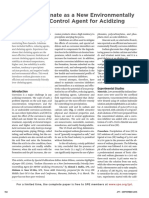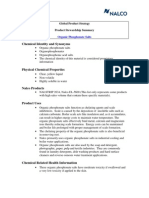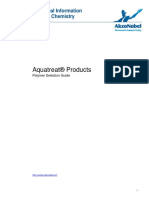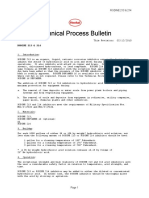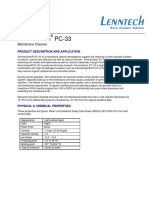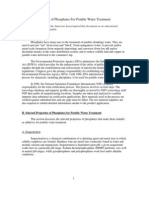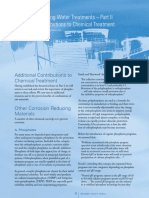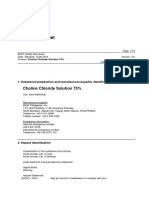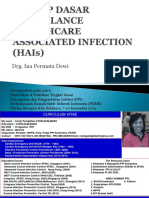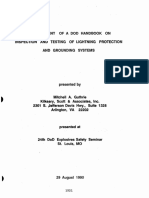Orthopolyphosphate Corrosion Inhibitors PDF
Orthopolyphosphate Corrosion Inhibitors PDF
Uploaded by
mudassarhussainCopyright:
Available Formats
Orthopolyphosphate Corrosion Inhibitors PDF
Orthopolyphosphate Corrosion Inhibitors PDF
Uploaded by
mudassarhussainOriginal Description:
Original Title
Copyright
Available Formats
Share this document
Did you find this document useful?
Is this content inappropriate?
Copyright:
Available Formats
Orthopolyphosphate Corrosion Inhibitors PDF
Orthopolyphosphate Corrosion Inhibitors PDF
Uploaded by
mudassarhussainCopyright:
Available Formats
Ortho-Polyphosphate Corrosion Inhibitors
Since the late 1980s, a new type of corrosion inhibitor has become increasingly popular in treating many water supplies. These inhibitors, classified as ortho/polyphosphate blends, represent a blend of two previous technologies that have been established over a much longer period of time. What follows is a bit about the history of ortho/polyphosphates, their mode of action, and applications where they may be likely to yield results.
olyphosphates (and when combined with a zinc source is sometimes referred to as bimetallic phosphates) have been used in treating drinking water supplies since the 1950s. Orthophosphates (specifically zinc orthophosphates) were first used in the late 1960s by Long Beach, CA. As polyphosphates will revert to the orthophosphate form over a period of time, the use of ortho/polyphosphate blends has actually been going on for as long a time as polyphosphates have been used in treating potable water. It was not, however, until the 1980s that some vendors began intentionally adding orthophosphate to a polyphosphate source to market a blended product. Today a full range of phosphate products with or without the addition of zinc is available.
Composition and Mode of Action
As the name implies, an ortho/polyphosphate blend is a product containing concentrations of an orthophosphate and polyphosphate source. As is the case with all phosphate based inhibitors, the properties of corrosion protection can be directly attributed to the film forming action of the inhibitor on the surface of the material being protected. The more uniform and tenacious the film, the better the corro48
sion protection. This film forming action can be the result of a number of mechanisms with the two most prevalent being either anodic or cathodic deposition. Without going into great detail, it is important to note that the deposition of a protective film is dependent essentially on a chemical precipitation process in the immediate area of the corroding surface. The environment within which this precipitation/film forming process takes place is typically different in some way from the bulk water environment. It is these differences that trigger the precipitation that leads to the deposition of the protective barrier that stifles further corrosion. An example of the above would be illustrated by the pH change that occurs in cathodic and anodic sites on a corroding metal. The solubility of various phosphate salts and compounds is often pH dependent. As the phosphate passes through the cathodic or anodic sites where the pH differs from that of the bulk water supply, the phosphate undergoes a change that results in the precipitation of a phosphate containing compound, which, hopefully, will attach itself to the active anode or cathode. Some of these compounds may form at higher and others lower pHs than the bulk water pH, which will determine whether the inhibitor is acting as a anodic or cathodic corrosion inhibitor. While the pH is probably the most
active player in promoting this film forming process, other factors undoubtedly play a role as well. Examples of these other factors likely include differences in oxidation potentials, corrosion byproducts, concentrations and chemical form of the phosphate, concentrations of other organic or inorganic compounds, or a combination of factors which, when present simultaneously, trigger the precipitation/film forming process.
Selection of Ortho/Poly Ratio
This is probably the most difficult and fickle step to undertake in the proper selection of the inhibitor. This is because, as previously mentioned, there are many factors that effect the film forming process that are not fully understood. As all waters differ from one another in their respective chemical makeup, it is virtually impossible to predict the effects of one ratio against another without experimentation. As it is known that both the ortho and poly forms of phosphate will form protective films under certain conditions, it cannot be determined which form should be maximized without a fair amount of study. Having said this, there are several theories regarding the role that each form plays in the film forming process. One popular theory rests on the known fact that polyphosphate will act to sequester cations in aqueous solutions while orthophosphates will not. It is also www.govengr.com
GOVERNMENT ENGINEERING
SEPTEMBEROCTOBER 2006
known that this sequestration property of polyphosphates has synergistic effects, which means that a small amount of polyphosphate will sequester a large amount of reactive cations. According to this theory, only enough polyphosphate should be added to the water supply to ensure that adequate sequestration takes place. An overdose of polyphosphate will act to strip the protective orthophosphate film so its concentrations should be minimized. Once the reactive cations (i.e., calcium, iron, and manganese) have been sequestered, which results in the concentrations of polyphosphate being consumed in this process, the orthophosphates will have the opportunity to react in the anodic or cathodic sites to form a protective film. In the absence of sufficient polyphosphate to sequester these reactive cations, the orthophosphate concentrations are consumed by forming premature precipitates with these cations rendering their resulting concentrations to be too low to form protective films at the actively corroding sites. Essentially, the polyphosphate plays the role of the sacrificial lamb in allowing the orthophosphate to remain available to do its job. Of course, if the application of the inhibitor is for sequestration purposes, the answer is easy. Choose the inhibitor with the best bang for the buck to maximize polyphosphate concentrations. It is doubtful that the presence of orthophosphate will be of any value in sequestering any metals in solution.
Conclusions
Ortho/polyphosphate corrosion inhibitors can often times be the best choice in selecting an inhibitor to solve a corrosion related problem. They are more environmentally friendly than some of the other alternatives as they contain no zinc, which can sometimes be considered objectionable. As they can, however, contribute to the growth of algae in open reservoirs, their use should be applied with caution where GE open reservoirs exist. The preceding is courtesy of Sweetwater Technologies, www.sweetwatertech.com. Part 5 of this series will discuss potable organic polymerstypes and applications. www.govengr.com GOVERNMENT ENGINEERING
SEPTEMBEROCTOBER 2006
49
You might also like
- Dow Industrial Water Treatment Scale Inhibitor and DispersantDocument19 pagesDow Industrial Water Treatment Scale Inhibitor and Dispersantdalton2004100% (2)
- Sodium Gluconate Iron Chelation ValueDocument2 pagesSodium Gluconate Iron Chelation ValueVenu KavetiNo ratings yet
- Cooling Water Product ListDocument3 pagesCooling Water Product ListBen Wiggins100% (1)
- Inhibitor Choice & DosageDocument6 pagesInhibitor Choice & DosagemnasiroleslamiNo ratings yet
- Formula Development - Cooling Water Treatment - ScrantonDocument12 pagesFormula Development - Cooling Water Treatment - ScrantonΔημήτρης ΝαλμπάντηςNo ratings yet
- BWA Belcor 575 Replaces Molybdate USA - WF 0Document2 pagesBWA Belcor 575 Replaces Molybdate USA - WF 0mnasiroleslami100% (2)
- 216Document16 pages216Mehdi NasiroleslamiNo ratings yet
- Nalco ACT: Boiler Water Operator Training NotesDocument4 pagesNalco ACT: Boiler Water Operator Training NotesSheikh Sahab100% (1)
- Organic Phosphonate SaltsDocument3 pagesOrganic Phosphonate SaltsDee HsNo ratings yet
- Neutralizing Amines: Boiler Water Operator Training NotesDocument4 pagesNeutralizing Amines: Boiler Water Operator Training NotesSheikh SahabNo ratings yet
- Water Soluble Polymers EDocument57 pagesWater Soluble Polymers Emini2018No ratings yet
- Product Bulletin - PC-67Document4 pagesProduct Bulletin - PC-67Aymen HentatiNo ratings yet
- Boiler Water Treatment: AlkalinityDocument21 pagesBoiler Water Treatment: AlkalinitySalwan Shubham100% (1)
- Open Cooling System Guide ALP 25 July 2013 Final VerDocument42 pagesOpen Cooling System Guide ALP 25 July 2013 Final VerivanrhsNo ratings yet
- ACUMER 3100 Boiler FormulationDocument12 pagesACUMER 3100 Boiler FormulationAlfonso Dominguez GonzalezNo ratings yet
- Closed Loop Chiller Water Non-Oxidizing MicrobiocideDocument20 pagesClosed Loop Chiller Water Non-Oxidizing MicrobiocidesunnyooiNo ratings yet
- Acumer3100 Cooling PDFDocument7 pagesAcumer3100 Cooling PDFdalton2003No ratings yet
- Kurita Recommnedation On Boiler Chemical TreatmentDocument12 pagesKurita Recommnedation On Boiler Chemical TreatmentSibabrata Choudhury100% (2)
- Scale and Corrosion Removal Chemical Treatment ProposalDocument3 pagesScale and Corrosion Removal Chemical Treatment ProposalsajjadNo ratings yet
- Boiler Water BBGS PDFDocument32 pagesBoiler Water BBGS PDFproloy12No ratings yet
- Neutralizing Amines Volume 10 Issue3Document3 pagesNeutralizing Amines Volume 10 Issue3Waleed Emara100% (1)
- Diethyl Hydroxylamine As Oxygen Scavanger For Boiler Water TreatmentDocument10 pagesDiethyl Hydroxylamine As Oxygen Scavanger For Boiler Water TreatmentDvsrani AnbananthanNo ratings yet
- Material Safety Data Sheet: Hydrex 2127Document4 pagesMaterial Safety Data Sheet: Hydrex 2127JHUPEL ABARIALNo ratings yet
- Paper PresentationDocument19 pagesPaper PresentationabhiiiiiiiiiiiiiiiNo ratings yet
- Acumer3100 BoilerDocument12 pagesAcumer3100 BoilerDonatas Bertasius100% (1)
- Aquatreat Selection GuideDocument3 pagesAquatreat Selection GuideMustafa KareemiNo ratings yet
- 8 Film Forming Amine FFSDocument47 pages8 Film Forming Amine FFSprakashNo ratings yet
- STD Spec For Boiler Chemical CompoundDocument21 pagesSTD Spec For Boiler Chemical CompoundSunny Ooi100% (1)
- KURITA - Boiler Preservation Methods (Part4) PDFDocument8 pagesKURITA - Boiler Preservation Methods (Part4) PDFIyan MulyanaNo ratings yet
- Closed System Protection Handbook PDFDocument10 pagesClosed System Protection Handbook PDFBrightwaterprocess100% (1)
- Rodine 213 & 214-EnDocument3 pagesRodine 213 & 214-EnLouis MoralesNo ratings yet
- Acumer 4161 - PCADocument7 pagesAcumer 4161 - PCAManuel PerezNo ratings yet
- A Volatile Oxygen Treatment SystemDocument10 pagesA Volatile Oxygen Treatment SystemmallinathpnNo ratings yet
- 05 AWT Water Treatment MicrobiologyDocument30 pages05 AWT Water Treatment Microbiologypofuduk_gsNo ratings yet
- Section 24 Neutralizing Filming AminesDocument3 pagesSection 24 Neutralizing Filming AminesSheikh SahabNo ratings yet
- A. DReeM Polymer Kurita ASEAN SourceDocument48 pagesA. DReeM Polymer Kurita ASEAN SourceSallyNo ratings yet
- Product Bulletin ELIMIN-OX enDocument2 pagesProduct Bulletin ELIMIN-OX enAaron ChanNo ratings yet
- Cetamine G900 - enDocument2 pagesCetamine G900 - endanielNo ratings yet
- Kurita Cetamine BrochureDocument2 pagesKurita Cetamine BrochureDanielWheelerNo ratings yet
- Diethyl Hydroxyl AmineDocument6 pagesDiethyl Hydroxyl AminemnasiroleslamiNo ratings yet
- Boiler Film Forming Amines Hydrocarbon Engineering Sept2015Document5 pagesBoiler Film Forming Amines Hydrocarbon Engineering Sept2015MarcTimNo ratings yet
- Selecting A Corrosion Inhibitor PDFDocument3 pagesSelecting A Corrosion Inhibitor PDFTariqNo ratings yet
- The Treatment of Cooling Water With Chlorine Dioxide PDFDocument10 pagesThe Treatment of Cooling Water With Chlorine Dioxide PDFMumtaz Ahmed GhummanNo ratings yet
- Chloride RemovalDocument12 pagesChloride Removaldilshad kapoor100% (1)
- Silica RemovalDocument2 pagesSilica Removaladehriya100% (1)
- Thermax Chemical Division Brochure PDFDocument24 pagesThermax Chemical Division Brochure PDFmathesis-2No ratings yet
- Water Log Newsletter - Jan 2013Document24 pagesWater Log Newsletter - Jan 2013Luis LicetNo ratings yet
- Ecolab Permaclean PC 33 LDocument3 pagesEcolab Permaclean PC 33 LKumbang KambingNo ratings yet
- 2012 Film-Forming Amines in Shell Boilers PPChemDocument11 pages2012 Film-Forming Amines in Shell Boilers PPChemYu XueNo ratings yet
- Calculation and Adjustment of Silica (Sio) Scaling For Reverse OsmosisDocument3 pagesCalculation and Adjustment of Silica (Sio) Scaling For Reverse OsmosismerksssNo ratings yet
- Deposit Control Polymers For Stressed Phosphate-Based Cooling Water SystemsDocument15 pagesDeposit Control Polymers For Stressed Phosphate-Based Cooling Water SystemsJohnNo ratings yet
- IDA-97 Silica AntifoulantDocument18 pagesIDA-97 Silica AntifoulantCyrus CerezoNo ratings yet
- 0372 0375 Vol A1 t02 Water ChemistryDocument71 pages0372 0375 Vol A1 t02 Water ChemistrySandeep MishraNo ratings yet
- Cooling Water - PackariousDocument57 pagesCooling Water - PackariousBrett RagonNo ratings yet
- Evaluating Polymers and Phosphonates For Use As Inhibitors For Calcium, Phosphate and Iron in Steam BoilersDocument23 pagesEvaluating Polymers and Phosphonates For Use As Inhibitors For Calcium, Phosphate and Iron in Steam Boilersmnasiroleslami100% (3)
- 2016 - MOMENI - Degradation and Hemostatic Properties of Polyphosphate CoacervatesDocument14 pages2016 - MOMENI - Degradation and Hemostatic Properties of Polyphosphate CoacervatesjuliocesarbpNo ratings yet
- Iron Oxide Hydroxide (GFO) Phosphate BindersDocument8 pagesIron Oxide Hydroxide (GFO) Phosphate BindersCharlesNo ratings yet
- Potable Water TreatmentDocument6 pagesPotable Water TreatmentAbsalon Fernando RiascosNo ratings yet
- Cooling Water Treatment Spring2008Document5 pagesCooling Water Treatment Spring2008Diego SamayoaNo ratings yet
- ASMEDocument8 pagesASMEEnrique ParedesNo ratings yet
- Nastaliq ScriptDocument9 pagesNastaliq ScriptmudassarhussainNo ratings yet
- Islaam Main Aurat Ka MuqaamDocument75 pagesIslaam Main Aurat Ka MuqaammudassarhussainNo ratings yet
- 1782 Ibas - WRC4 Ibas PDFDocument1 page1782 Ibas - WRC4 Ibas PDFmudassarhussainNo ratings yet
- Cold Working of Brass PDFDocument8 pagesCold Working of Brass PDFmudassarhussainNo ratings yet
- Discrete I/O Modules: WRC4 SeriesDocument15 pagesDiscrete I/O Modules: WRC4 SeriesmudassarhussainNo ratings yet
- Cold Working, Recrystallization, and Grain Growth of Brass: 1.0 Learning ObjectivesDocument8 pagesCold Working, Recrystallization, and Grain Growth of Brass: 1.0 Learning ObjectivesAbhishek PandeyNo ratings yet
- Print PDFDocument1 pagePrint PDFmudassarhussainNo ratings yet
- Adnan PDFDocument3 pagesAdnan PDFmudassarhussainNo ratings yet
- Periodontal Plastic and Esthetic SurgeryDocument7 pagesPeriodontal Plastic and Esthetic SurgeryAhmed IbrahimNo ratings yet
- Home Based Postnatal Care: Training of Child Health ManagersDocument33 pagesHome Based Postnatal Care: Training of Child Health ManagersDr Rajan DubeyNo ratings yet
- Full Download of Test Bank for Molecular Biology of the Cell Sixth Edition in PDF DOCX FormatDocument57 pagesFull Download of Test Bank for Molecular Biology of the Cell Sixth Edition in PDF DOCX Formatarmiolokite100% (3)
- Machine Technical Review and Training GuideDocument124 pagesMachine Technical Review and Training GuideJuan Manuel MuñozNo ratings yet
- Miracles of HoneyDocument49 pagesMiracles of Honeyejaz_khan100% (1)
- 01 TL Design AspectsDocument4 pages01 TL Design AspectschandrakantnuNo ratings yet
- Intl J Eating Disorders - 2015 - McLean - Photoshopping The Selfie Self Photo Editing and Photo Investment Are AssociatedDocument9 pagesIntl J Eating Disorders - 2015 - McLean - Photoshopping The Selfie Self Photo Editing and Photo Investment Are AssociatedKrzysztof FejdaszNo ratings yet
- Quality at TAPF - AssignmentDocument4 pagesQuality at TAPF - AssignmentramzanNo ratings yet
- NFDN 2004 Professional PortfolioDocument2 pagesNFDN 2004 Professional Portfolioapi-32048921050% (2)
- Enhancing Intelligence: From The Group To The IndividualDocument20 pagesEnhancing Intelligence: From The Group To The IndividualSebastiánsillo SánchezNo ratings yet
- LILY BASICS - Part 2 - Morphology W PhotosDocument2 pagesLILY BASICS - Part 2 - Morphology W PhotosEssay NationNo ratings yet
- Inert Gas SystemsDocument69 pagesInert Gas Systemspilotboygps100% (1)
- Safety Data Sheet: Choline Chloride Solution 75%Document10 pagesSafety Data Sheet: Choline Chloride Solution 75%Daniel DíazNo ratings yet
- Basic Counselling SkillsDocument3 pagesBasic Counselling Skillsjiajun898No ratings yet
- Adamm Creel Paper 2 AtonementDocument5 pagesAdamm Creel Paper 2 AtonementAdamm CreelNo ratings yet
- Watford 2001Document7 pagesWatford 2001CARDIO 2019No ratings yet
- BS 5908-2 - 2012Document54 pagesBS 5908-2 - 2012Luís SilvaNo ratings yet
- Aspects /component OF PharmacyDocument10 pagesAspects /component OF PharmacyAlanNo ratings yet
- TSR016 Ball ValvesDocument18 pagesTSR016 Ball Valvesbmanojkumar16No ratings yet
- Konsep Dasar Surveilans 2019Document72 pagesKonsep Dasar Surveilans 2019Rina Abdul GaniNo ratings yet
- Complaints Management System PresentationDocument28 pagesComplaints Management System Presentation3049005No ratings yet
- Mechanic CV Template PDFDocument2 pagesMechanic CV Template PDFmohamadreza007No ratings yet
- Design Philosophy FPS-LPG Terminal Bhatinda PDFDocument6 pagesDesign Philosophy FPS-LPG Terminal Bhatinda PDFAlvin Smith100% (1)
- Ada 526818Document22 pagesAda 526818Hamid Paminto NugrohoNo ratings yet
- SriLanka Disability FactsheetDocument10 pagesSriLanka Disability FactsheetBaraNo ratings yet
- EvolutionDocument108 pagesEvolutionKanmani SathiachandranNo ratings yet
- Literature ReviewDocument2 pagesLiterature ReviewLeah DulayNo ratings yet
- Previous Year Questions - Carbon and Its Compounds - 2 - Science Class 10 PDF DownloadDocument36 pagesPrevious Year Questions - Carbon and Its Compounds - 2 - Science Class 10 PDF DownloadMenaka SrinivasanNo ratings yet
- Physical Development of Infants and ToddlersDocument39 pagesPhysical Development of Infants and ToddlersMylene Mahinay80% (5)
- BA MadAss 50 EnglishDocument83 pagesBA MadAss 50 EnglishJoão CruzNo ratings yet

